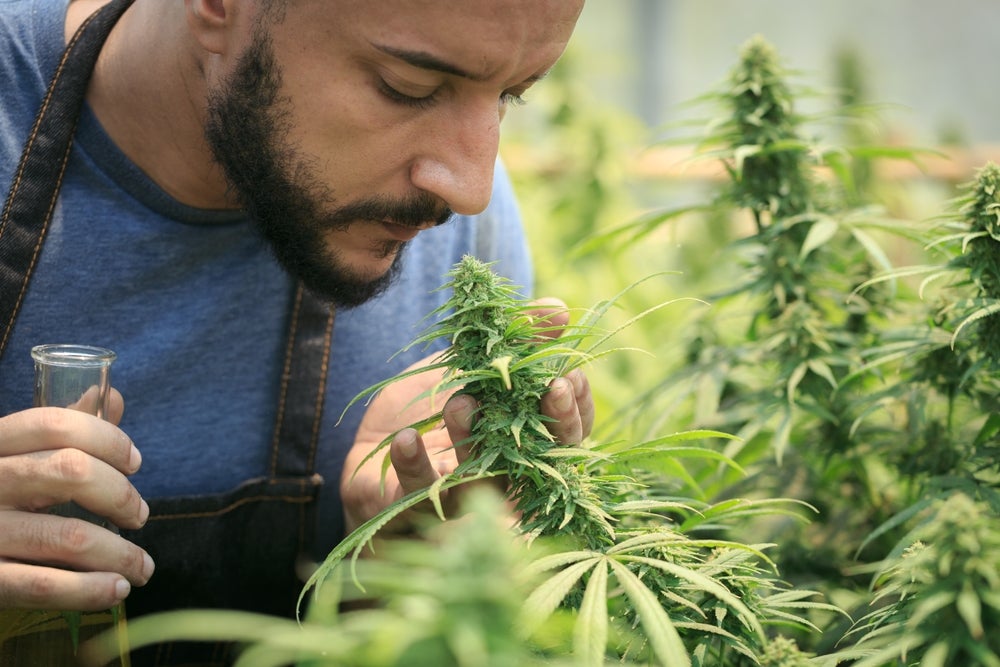Table of Contents
- What is Autoflower Cannabis?
- The Benefits of Autoflower Cannabis
- How to Grow Autoflower Cannabis
- Autoflower Cannabis FAQ
- Growing and Buying Autoflower Cannabis in Canada
Whether growing sativa or indica-dominant strains, autoflowering cannabis is an effective option worth noting. With a simpler cultivation method and fewer demands during the growing process, autoflower cannabis is a popular choice for both amateur and experienced growers.
Though autoflower cannabis is considered low maintenance in the world of cultivation, there are still several important factors to consider before diving into these popular strains.
If you’re considering growing autoflower cannabis, or are curious about these plants, here’s what you need to know about its seeds, nutrients, soil, and more.
What is Autoflower Cannabis?
Before we get into how to grow and produce autoflowers, we should cover the basics of autoflower cannabis.
Autoflower strains of cannabis are characterized by their easy cultivation method and low-maintenance qualities. Autoflowering cannabis refers to strains that flower automatically without grower intervention.
Autoflower cannabis strains are known for:
- Faster cycles
- Low maintenance growing
- Easy cultivation
- Automatic phase shifting
You may be thinking plenty of cannabis strains are easy to grow! What makes autoflower different from any other strain? The difference is in the genetics.
What’s the Difference Between Autoflower Cannabis and Other Strains?
What sets these strains apart from photoperiod cannabis (non-autoflowering strains) is the growth and flowering cycle. Other strains need the help of a grower to change the lighting, which then triggers the shift from the plant’s vegetative state to the flowering phase of growth. Autoflower, on the other hand, does this all on its own.
That’s right – autoflowering strains of cannabis don’t need no man. Or human, for that matter.
Autoflower cannabis is an adapted subspecies of the cannabis plant that has evolved to adapt to its environment. The adapted gene is how the plant can grow faster and without light or temperature change shifts implemented by a human.
They are capable of shifting into the flowering phase without a manual light shift. With autoflower strains, your plants will begin budding after their vegetative phase. This automatic shift is due to the plant’s ability to change phases without the intrusion of temperature and light exposure changes.
The Benefits of Autoflower Cannabis
Many cannabis growers are intrigued and attracted to autoflower strains. There is a range of benefits to planting and growing these genetic beauties.
1. The soil requires less nutrients
Depending on how much time you have to put into your cannabis plants, keeping the soil healthy can be a big task. For cannabis plants to thrive, it’s essential to work with nutrient-dense soil – which can take years to get right.
Autoflowering plants have the benefit of relying much less on added nutrients in the soil. These plants are lower-maintenance thanks to the genetic qualities they possess, which allow them to adapt to the climate, environment, and soil they find themselves in.
Fewer nutrient requirements mean you will spend less time figuring out the exact combination of peat moss, topsoil, and worm castings for your soil! It also means growers spend less money on fertilizers and pricey nutrient additives.
2. Plant growth cycles are faster
Autoflower plants are known for their fast growth cycle. It’s a huge benefit for commercial growers looking to produce large quantities or for craft growers with a small in-house team and a high client demand.
Autoflower plants have a growth cycle that takes somewhere between seven and ten weeks. It might sound long, but it’s a snap compared to other species of the plant that can take between four and eight months!
3. Less lighting maintenance required
Since autoflowering plants don’t need a person around to change their temperature, they require much less maintenance in the lighting department.
Unlike other plants, which can require a repetitive on-off shift in lighting, autoflower cannabis plants can thrive at a maintained 18-hour-on schedule. This means you can switch on the overheads and let the plants do their thing for nearly a full day at a time.
4. Potency and effects
In addition to less maintenance and time spent worrying about soil, lighting, and temperative, it has some marketable client benefits, as well.
The species of autoflower cannabis known as cannabis ruderalis contains the genetics necessary to provide higher levels of CBD content. This higher level of CBD has plenty of practical benefits for the harvested plants. CBD products are used in medical products as well as THC and CBD-balanced products for a blend of psychoactive and therapeutic benefits.
The Dark Side of Autoflower Cannabis
While autoflower strains might be simpler and easier to grow, there are also downsides to choosing autoflowers.
- To start, given the faster growth rate, autoflowering plants tend to be shorter than other strains. Whereas cannabis plants can typically grow to above 4 meters, autoflower plants will grow to around .5 to .6 meters.
However, depending on your growing needs, a shorter plant height can also be a benefit. Shorter plants can be more discreet and save space for low-budget craft and small-batch growers.
- Secondly, autoflower cannabis can actually cost more – a fact you’ll notice when you get the electric bill. Since it can grow on a steady lighting schedule, the 18/hour lighting might start to add up.
- Lastly, autoflower cannabis – while more efficient – may not be more effective. The shorter growth cycle of the plant gives it less time to naturally produce quality buds. Less time spent developing inevitably leads to less developed plants, meaning the plants can produce fewer usable buds and less end product.
How to Grow Autoflower Cannabis
Growing autoflower cannabis might sound simple, but like any living thing, these plants still require a lot of care and attention. And sometimes, some trial and error.
Seeds
The first step to beginning the journey of growing autoflower cannabis is choosing the right strain. This also means planting high-quality seeds. Take your time, do your research, and choose the right strain for your needs and growing goals.
Soil and Nutrients
While autoflower soil requires less added nutrients, starting off with high-quality soil is still a must. Cannabis plants do best when interacting with soil that’s been cultivated over time to help the plant develop a natural symbiotic relationship. Simply put, good weed grows from good soil.
Light Cycles
Unlike other cannabis plant species, autoflower plants don’t need a lot of on-and-off when it comes to lighting. They are able to adapt to more extended periods of lighting. However, it’s still important to figure out precisely what period of time your plants require. As we’ve mentioned, finding this perfect balance can sometimes require tests and analysis!
Cultivation and Harvesting
When it is time to harvest your plants, it should be done with care. Since the plants have had less time to develop than other strains, the buds may be relatively small and delicate. It’s important to cut with care to avoid losing any valuable trichomes.
Avoid cutting the plant too deep. This can harm or permanently damage the plant and prevent it from launching into a new growth cycle.
Autoflower Cannabis FAQ
Still have some questions about autoflower cannabis? Let’s dive into a few frequently asked questions regarding growing and producing this species of cannabis plant.
Are autoflower cannabis worth growing?
Planting and growing autoflowering cannabis strains is a viable option for both large and small growers. The lower maintenance is more achievable for a small team, and the faster growth rate can be a benefit for commercial growers short on time.
How much does an autoflower yield?
Given the faster life cycle of autoflowering plants, buds have less time to grow and develop. Overall, it will likely yield less usable product.
How often should you water autoflowers?
How often you should water your autoflowers depends on a range of conditions and the environment. Areas with higher levels of humidity will require less watering, while dry, hot climates might need double the amount of water. The pot size, soil type, and pot type also come into play. Typically, you should expect to water your plants when they are up to 70% dry.
Do Autoflowers grow better outside?
It’s definitely possible to grow your autoflower plants outdoors! In fact, these shorter, faster plants are a popular choice for outdoor growers as they are both discreet and can be grown in colder climates. They are a good option for growing in locations where a shorter summer hinders plants with longer growth cycles from developing.
Should you cut autoflower plants?
When harvesting and cutting your plants, do so with care. Autoflower plants require less attention but can be more delicate during the harvesting phase. To avoid damaging your plant, cut as little as possible and handle buds with caution.
Growing and Buying Autoflower Cannabis in Canada
Autoflowering strains of cannabis pose plenty of benefits for growers looking for a simpler method for cultivating cannabis plants. The potential for faster growth with less human intervention is a big plus for both craft growers and commercial growers.
While faster grow times are a plus, there are also some downsides to consider when it comes to autoflower cannabis. Many growers, however, feel the benefits outweigh the cons!
Autoflower cannabis strains require much less attention and time from growers, making them a popular choice for cannabis for growers in Canada. Would you try growing an autoflower strain?
Sources:
https://autoflowering-cannabis.com/
https://www.leafly.ca/learn/cannabis-glossary/autoflower
https://growithjane.com/nutrients-cannabis-plants/
https://2fast4buds.com/news/how-often-should-i-water-my-cannabis-plants


